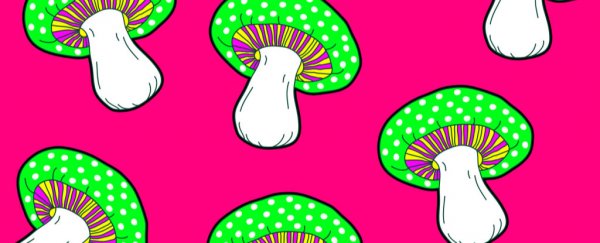Scientists have found a new way to harvest psilocybin, the psychedelic compound typically found in mushrooms. They've engineered bacteria to produce psilocybin in their cells and poop it out, in gram-scale concentrations that are higher than any other bioengineered organism to date.
It is, the researchers say, a significant step towards demonstrating the feasibility of industrial-scale production of the drug.
Psilocybin is found in over 200 fungus species, and has long enjoyed a reputation for its psychedelic and hallucinogenic properties. In recent years, however, it has become increasingly evident that psychedelic drugs also have serious potential for treating conditions such as treatment-resistant depression.
But mass-producing the compound from mushrooms would require a lot of time, and a lot of space to grow the fungi. So a team of biochemists led by Andrew Jones and Alexandra Adams of Miami University decided to try something else - metabolic engineering.
This is a biosynthesis process that relies on changing cells so they will produce compounds they don't naturally produce, or in quantities they don't naturally produce; one example of this is bioethanol, which can be used as biofuel.
A popular bacterium for this purpose is Escherichia coli, since it is easy to engineer, prolific, well understood and has a large and versatile array of genetic tools available for engineering. So, this is what the team used as their host.
They introduced psilocybin-producing genes from the quintessential ' magic mushroom' Psilocybe cubensis into the bacterium, to see if that would induce the microbes to produce psilocybin. It worked, with varying levels of success.
"We are taking the DNA from the mushroom that encodes its ability to make this product and putting it in E. coli," Jones said.
"It's similar to the way you make beer, through a fermentation process. We are effectively taking the technology that allows for scale and speed of production and applying it to our psilocybin producing E. coli."
The researchers identified the bacterium strain that produced the greatest concentration of psilocybin, greatest reliability, and low buildup of intermediate products.
Dubbing this strain pPsilo16, they then worked to optimise its production, through a series of experiments to provide the best fermentation conditions. This provided the best base media, the best temperature and the best nutrient mix for producing psilocybin.
Finally, the team was able to scale their production up into large bioreactors, fine-tuning the process to eventually produce a concentration of 1.16 grams of psilocybin per litre - the first demonstration of psilocybin in a prokaryotic host, and the highest concentration of psilocybin produced by any recombinant organism to date.
(The concentration of psilocybin in P. cubensis itself varies, but it's between 0.37 and 1.30 percent of the dry weight of the entire mushroom.)
"What's exciting is the speed at which we were able to achieve our high production," Jones said. "Over the course of this study we improved production from only a few milligrams per litre to over a gram per litre, a near 500-fold increase."
Clinical trials for psilocybin as a treatment for depression are currently ongoing. Meanwhile, Jones and his team are investigating ways to make E. coli an even better host for the psilocybin genes.
The research has been published in Metabolic Engineering.
